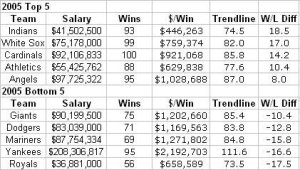 We all know about the large money disparities in baseball and how it sometimes leads to having the same teams in the playoffs (especially in the AL) year after year. This year, the Yankees once again lead the majors in team salary at just over $209 million while the Marlins are just under $22 million (less than what A-Rod is making) at the bottom. So in theory, if every team was efficient in their salary paid to performance on the field, the Yankees should have 10 times as many wins as the Marlins, but in reality, only 1 win separates the teams.
We all know about the large money disparities in baseball and how it sometimes leads to having the same teams in the playoffs (especially in the AL) year after year. This year, the Yankees once again lead the majors in team salary at just over $209 million while the Marlins are just under $22 million (less than what A-Rod is making) at the bottom. So in theory, if every team was efficient in their salary paid to performance on the field, the Yankees should have 10 times as many wins as the Marlins, but in reality, only 1 win separates the teams.
The reality is that there is a lot more parity in baseball than we are led to believe, especially since it is a sport where it is a major accomplishment to have a winning percentage over .600 (98 wins). In the NFL, that’s the equivalent of 10-6. We’ve all seen the dollars per wins statistic before, usually to show the Yankees gross overspending versus an overachieving small market team, but those sort of numbers obviously do not reflect anything that could be realistically expected out of 2 baseball teams, because no team ever wins 5-10 times as many games as another team, or even on a smaller scale, spending twice as much never actually promises twice the wins.
So I decided to create the Bang for the Buck ratings, which is set up to compare a team’s win total in a season compared to what their expected win total should be based on their salary and  the performance of other teams with similar salaries. To do this, I created a linear regression plot of all the teams of their win total versus salary, and used that linear relationship to define the expected win total of a team based on their salary. The farther from the line an individual team is, the greater or smaller “bang for the buck” a team got that season. So yes, an overachieving small market team will always be near the top of the list, but it’s also interesting to see where other teams fall, especially the big spending teams, who are expected to win a high number of games. Speaking of those teams, I did the calculation each year from 2004-2008 and I decided that if a team’s salary was more or less than 3 standard deviations from the average, they would be considered “outliers” and excluded from the regression calculation, but the regression could still be used to calculate an expected win total. Each year, the Yankees were the only team in this category. Playoffs are not factored into these ratings.
the performance of other teams with similar salaries. To do this, I created a linear regression plot of all the teams of their win total versus salary, and used that linear relationship to define the expected win total of a team based on their salary. The farther from the line an individual team is, the greater or smaller “bang for the buck” a team got that season. So yes, an overachieving small market team will always be near the top of the list, but it’s also interesting to see where other teams fall, especially the big spending teams, who are expected to win a high number of games. Speaking of those teams, I did the calculation each year from 2004-2008 and I decided that if a team’s salary was more or less than 3 standard deviations from the average, they would be considered “outliers” and excluded from the regression calculation, but the regression could still be used to calculate an expected win total. Each year, the Yankees were the only team in this category. Playoffs are not factored into these ratings.
Let’s take a look at the results, starting with the top and bottom 5 for 2007: The top 4 teams all share a pretty common trend. They were all pretty young teams that overachieved in 2007, with 3 of them making the playoffs and the 4th losing a 1 game playoff. The Angels are a “big money” team that still manged to get a lot out of their team, gaining 94 wins and the AL West title. The bottom 5 featured the 5th highest salary from 2007, the White Sox, who had a horrible injury plagued season, but also the small market Royals, who were hurt by having a salary higher than 4 of teams in the top 5 but only put up 69 wins. The Astros, Giants, White Sox, and Orioles actually should have put up winning seasons based on their salary and the performance of others but were battling for last in their divisions. The team that came closest to getting what they paid for was the Twins, who had 79 wins and were expected to get 79.5. You may notice that the trendline shows everyone was projected to be around .500, and that was due to a lot of low salary teams doing very well last year, and also opens up another trend I’ll discuss later….
The top 4 teams all share a pretty common trend. They were all pretty young teams that overachieved in 2007, with 3 of them making the playoffs and the 4th losing a 1 game playoff. The Angels are a “big money” team that still manged to get a lot out of their team, gaining 94 wins and the AL West title. The bottom 5 featured the 5th highest salary from 2007, the White Sox, who had a horrible injury plagued season, but also the small market Royals, who were hurt by having a salary higher than 4 of teams in the top 5 but only put up 69 wins. The Astros, Giants, White Sox, and Orioles actually should have put up winning seasons based on their salary and the performance of others but were battling for last in their divisions. The team that came closest to getting what they paid for was the Twins, who had 79 wins and were expected to get 79.5. You may notice that the trendline shows everyone was projected to be around .500, and that was due to a lot of low salary teams doing very well last year, and also opens up another trend I’ll discuss later….
Here are the results for 2006:
Now we’ll take a look at 2005:
And now, the first year I started looking at this, 2004:
Going into today’s games, so far in 2008 the Rays are getting the most bang for the buck, 12.5 games better than what would currently be expected of their salary, followed by the Angels, Cubs, Marlins, and Twins. The worst bang for the buck is the Mariners, followed by the Natonals, Padres, Giants, and last year’s best bang for the buck team, the Indians.
As I mentioned above, I have noticed a pretty significant trend from 2004-2007 that seems like it could continue in 2008:
1. Big market teams are increasingly (and stupidly) overpaying superstar players, because their salaries keep climbing while the small market teams are catching them in the standings.
2. Being a small market team is no excuse for being a bad team, which has been proven several times in the past 5 years by teams with very low salaries, but a small market team may need to increase its spending to lock up a spot in the playoffs every year.
We’ll see how the rest of 2008 goes. I may post an update with some better 2008 numbers as we head into the September stretch run.
Add The Sports Daily to your Google News Feed!